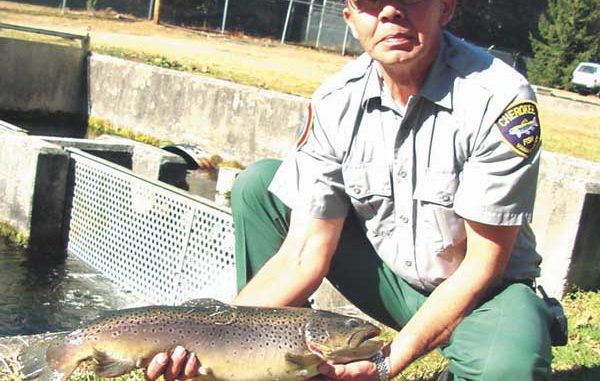
Prompted in part by one of its worst fishing seasons in recent history, Cherokee fishery officials are planning a major upgrade of the tribe’s popular fishing program.
Bob Blankenship, program director, said the primary goal is to update and expand the tribal hatchery. Other goals are to install safeguards to lessen the impact of cyclical droughts such as the one that hit the Southeast last summer.
Blankenship said the tribe lost three raceways of trout because of high water temperatures, which, at times, climbed to 72 degrees. Fewer fish were stocked, and fewer fishing permits were sold during the prime tourist season at Cherokee.
The Eastern Band of the Cherokee Indians has been operating its catch-and-keep trout fishing program for more than 40 years, offering generous creel limits and heavily stocked streams. The 30-miles of streams and ponds that make up Cherokee Enterprise Waters are stocked annually with 360,000 rainbow trout that run between 8 and 10 ounces, plus hundreds of brown and brook trout in the trophy category. Anglers may keep up to 10 trout a day. There are no size limits and no lure or bait restrictions.
With the exception of Soco Creek, which originates in northern Jackson County, all Enterprise streams are formed in the adjoining Great Smoky Mountains National Park. Even with heavy fishing pressure and frequent stockings, the streams have some natural reproduction. Plus, a number of wild trout are either washed down or migrate from park streams.
Daily creel limits often include a wild trout or two.
Enterprise waters include the Oconaluftee River from the park boundary on U.S. 441 to the reservation boundary on U.S. 19 at Birdtown, Raven Fork and Bunches Creek in the Big Cove section of the reservation, and Soco Creek, which enters the Oconaluftee in downtown Cherokee.
Additionally, the tribe has several ponds near the KOA campground at Big Cove. The ponds operate under catch-and-release regulations.
The majority of the trout stocked in Enterprise Waters are raised in the tribal hatchery at the head of Big Cove. Trout are raised from eggs, and the hatchery keeps between 400,000 to 500,000 trout in its raceways, every length from fry to stocking-size trout. The tribe gets additional trout from federal hatcheries in Tennessee and Georgia. Eggs come from a federal hatchery at Ennis, Montana.
Blankenship assumed duties as program director during December 2007 after spending 19 years managing a salmon hatchery in Moose Pass, Alaska. He has worked in fish production most of his life. His father owned and operated a commercial hatchery at the reservation for years, and Blankenship helped his father build the hatchery during summers off from his university studies.
To mitigate the impact of drought, Blankenship said the old hatchery will be upgraded and expanded, a liquid oxygen system installed to keep raceways oxygenated, a couple of wells dug to provide a more consistent source of water, and the tribe may install a water-recycling system.
Straight Fork Creek, which forms in the Great Smoky Mountains National Park, is the primary water source for the hatchery.
“We were using 100 percent of the water from Straight Fork, and it still wasn’t enough,” Blankenship said last summer.
The tribal hatchery has 26 outside raceways. Four are 20-feet wide by 90-feet long, and the rest are 10-feet wide and 90-feet long. Two inside raceways are used to hatch eggs.
“We’ll double the number of raceways when we’re at full production,” Blankenship said. The goal, he said, is to have the upgrades and expansion completed by 2009.
Once the upgrades and expansion are completed, Blankenship said the tribe also is looking at other means to enhance the fishing experience, such as establishing sections for catch-and-release fishing and trophy fishing.
For now, the emphasis will be establishing safeguards to survive drought conditions, which are predicted to last at least another year.
Another project unrelated to the fishing program is the stocking of sickle fin red horse in the Oconaluftee River, a joint enterprise with the N.C. Wildlife Resources Commission and the U.S. Fish and Wildlife Service. The objective is to restore the red horse to its native habitat.
Blankenship said 800 red horse were stocked this summer, and biologists will monitor the fish to see how successfully they adapt. While red horse often grow to 4 to 6 pounds and larger, they’re not considered a game fish.
Fishing in Enterprise Waters is permitted from the last Saturday in March to the end of February. Tribal streams always open a week before state hatchery-supported streams, giving area anglers two weekends of prime meat fishing. Enterprise waters are stocked three times a week.
Cherokee does not require any license other than a tribal permit. Permits are $7 daily $20 for three days, $28 for five days and $200 for the season.




Be the first to comment